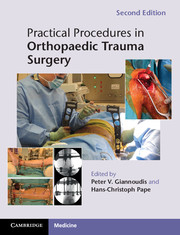Section III: Fractures of the distal radius
Published online by Cambridge University Press: 05 February 2014
Summary
Indications
Unstable, displaced, irreducible extra-articular fractures (A3).
Unstable, partial (B1, B2, B3) or complete (C2, C3) intra-articular fractures. The volarly displaced partial articular fracture (Barton's fracture) is a classic indication.
Surgical fixation of distal radius fractures is recommended when post-reduction radiographs reveal more than 3 mm of radial shortening, 10 degrees of dorsal angulation and 2 mm of an intra-articular step or gap.
Fractures requiring bone grafting, malunion and non-union procedures.
Preoperative planning
Clinical assessment
Obtain a detailed history of the patient, including age, hand dominance, occupation and level of activity.
Mechanism of injury: grading from low- to high-velocity trauma. Fall on outstretched hand (FOOSH) is the most common mechanism.
Evaluate neurovascular status of the hand.
Assess soft tissue damage.
Typically deformity, swelling and tenderness are present.
Check for associated ligamentous lesions and fractures of carpal bones.
Radiological assessment
High-quality anteroposterior and lateral radiographs (Fig. 5.5.1).
Oblique ilms (45 degrees, pronated and supinated).
Assess degree of fragment displacement, quality of bone, whether the fracture is intra-articular or extra-articular, direction of displacement, metaphyseal comminution.
The Fernandez classiication of distal radius injuries is particularly helpful because it takes into account the mechanism of injury (bending, shearing, compression, avulsion and combined mechanisms), estimates the stability of the injury, predicts the presence of associated injuries and guides treatment.
CT scan is useful when the diagnosis is not clear in plain radiographs or when a more complex fracture pattern is present and consequently a more complex management plan needs to be formulated.
Information
- Type
- Chapter
- Information
- Practical Procedures in Orthopaedic Trauma Surgery , pp. 134 - 148Publisher: Cambridge University PressPrint publication year: 2014
